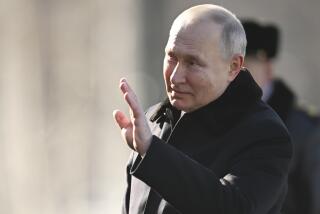Questions to Ask on Missile Defense
- Share via
Our national security advisor, Condoleezza Rice, opposes anything that might hold up missile shield plans (July 27). Once again, the administration is trying to railroad something through before there is adequate time to discuss and debate it.
A national missile defense will be astronomically expensive, with no end in sight. Two out of four tests, under tightly controlled circumstances, were total failures, the other two only partially successful. And NMD will do nothing to prevent terrorists from bringing nuclear bombs into our country in trucks or suitcases. Worst of all, to abrogate the Antiballistic Missile Treaty can only lead to a return to nuclear terror.
There are two diametrically opposed paths we can follow. One, the administration’s, will lead to a deadly arms race and a possible nuclear war. The other, the only sane one in this interdependent world of ours, means strengthening the treaties we have, taking all weapons off nuclear alert by mutual agreement and eventually working to eliminate these weapons from the face of the Earth.
Ann Edelman
Los Angeles
*
There is an important aspect of the national missile defense debate that I believe has been overlooked. When originally signed, the ABM Treaty constrained strategic defenses to a total of 200 launchers and interceptors, 100 at each of two widely separated deployment areas. This was later modified to reduce the number of ABM deployment areas permitted each side from two to one and the number of ABM launchers and interceptors from 200 to 100.
Implementation in the U.S. was, in 1975-76, a single U.S. Safeguard ABM deployment site with 100 launchers and interceptors and associated radars at Grand Forks, N.D. Cost-effectiveness was questioned, leading to a decision to decommission. Note that the U.S. unilaterally decommissioned its only facility without negotiating a similar decommissioning of an equivalent Soviet installation.
It is my recollection that the treaty allowed one of the original two defensive missile installations to be at the respective U.S. and Soviet capitals, and that the Soviets installed their array around Moscow. The U.S. not only did not install one around Washington, it removed the one in North Dakota.
Do the Russians still have a ring of defensive missiles around Moscow? If they do, as still permitted by the ABM Treaty, where do they, our friends in Europe and U.S. liberals get off claiming that the U.S. installing a much smaller number of defensive missiles for use against rogue missile launches constitutes a destabilizing act that threatens a new arms race?
William E. Haynes
Rancho Palos Verdes
More to Read
Sign up for Essential California
The most important California stories and recommendations in your inbox every morning.
You may occasionally receive promotional content from the Los Angeles Times.













